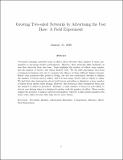Growing Two-Sided Networks by Advertising the User Base: A Field Experiment
Author(s)
Tucker, Catherine Elizabeth; Zhang, Juanjuan
DownloadEDG_2010_01_11.pdf (187.4Kb)
OPEN_ACCESS_POLICY
Open Access Policy
Creative Commons Attribution-Noncommercial-Share Alike
Terms of use
Metadata
Show full item recordAbstract
Two-sided exchange networks (such as eBay.com) often advertise their number of users, presumably to encourage further participation. However, these networks differ markedly on how they advertise their user base. Some highlight the number of sellers, some emphasize the number of buyers, and others disclose both. We use field experiment data from a business-to-business website to examine the efficacy of these different display formats. Before each potential seller posted a listing, the website randomized whether to display the number of buyers and/or sellers, and if so, how many buyers and/or sellers to claim. We find that when information about both buyers and sellers is displayed, a large number of sellers deters further seller listings. However, this deterrence effect disappears when only the number of sellers is presented. Similarly, a large number of buyers is more likely to attract new listings when it is displayed together with the number of sellers. These results suggest the presence of indirect network externalities, whereby a seller prefers markets with many other sellers because they help attract more buyers.
Date issued
2010-01Department
Sloan School of ManagementJournal
Marketing Science
Publisher
Institute for Operations Research and the Management Sciences
Citation
Tucker, C., and J. Zhang. “Growing Two-Sided Networks by Advertising the User Base: A Field Experiment.” Marketing Science 29.5 (2010): 805–814.
Version: Author's final manuscript
ISSN
0732-2399
1526-548X